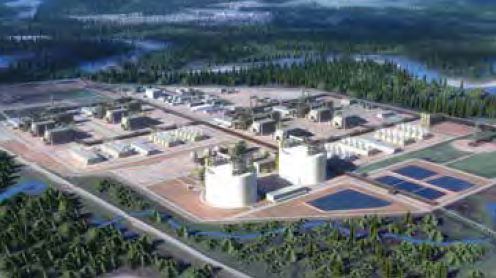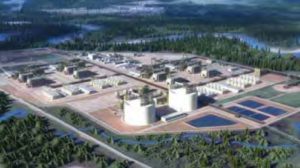LNG project could deliver $23 billion to B.C.

Artist's rendering of LNG Canada's proposed liquid natural gas terminal at Kitimat on the west coast of British Columbia. Illustration courtesy LNG Canada.

The three remaining partners in a $40 billion megaproject that aims to export liquefied natural gas to Asia from a port on the west coast of British Columbia formally announced an investment decision on Tuesday.
It is a move that triggers the largest private sector investment in Canadian history, Prime Minister Justin Trudeau told a press conference in Vancouver
PetroChina and South Korea’s Kogas announced last week that they have granted their approval for a plan that would see the LNG Canada consortium build an LNG export facility in Kitimat and 670-km pipeline that will transport natural gas to the coast from northeastern B.C.
The other three partners – Royal Dutch Shell Plc, Malaysia’s Petroliam Nasional Bhd., and Mitsubishi have now approved the final investment decision.
“I can’t stop smiling,” B.C. Premier John Horgan told reporters as he looked ahead to an investment boom that could benefit mega-project equipment and service suppliers such as Enterprise Oilfield Group Inc. [E-TSX], Macro Enterprises Inc. [MCR-TSXV], and Entrec Corp. [ENT-TSXV].
The project is expected to generate about $23 billion in revenue for B.C. over 40 years – money that the government says will be invested in health care, schools, child care and other key services.
Analysts say opportunities will flow to operators at the Septimus and Montney natural gas fields in northeastern B.C., which are expected to emerge as ground zero for a future LNG operation, producing natural gas that would be piped to the west coast, loaded onto ships and transported to markets in Asia.
LNG Canada said British Columbia was considered the right location for the project because it has the second largest natural gas reserves in Canada and is a reasonable distance from Asian markets.
An LNG spokesperson told The Globe and Mail last week that there are still some hurdles ahead for the partners to consider, including an Indigenous protest camp along TransCanada Corp.‘s [TRP-TSX] planned Coastal GasLink route, and an effort by environmentalists to send the pipeline proposal to the National Energy Board for a new review.
Published reports say the LNG project could test the B.C. Green Party’s commitment to propping up the province’s ruling NDP government. “Adding such a massive new source of greenhouse gas emissions means that the rest of our economy will have to make even more sacrifices to meet our climate targets,” said B.C. Green Party leader Andrew Weaver.
To export natural gas, it first needs to be turned into liquid form, which reduces its size 600-fold and makes it practical to ship via specially designed LNG marine vessels. To do this, gas is cooled to -162 degrees Celsius. At that temperature it turns into liquid.
Back in April, 2017, LNG Canada announced that a joint venture between JGC Corp. [JGCCF-OTC] and Fluor Corp. [FLR-NYSE] have been selected as the project’s engineering, procurement and construction contractor. It said JGC and Fluor will be responsible for directly hiring the majority of the thousands of skilled workers required during the 5-year construction period.
LNG Canada is a joint venture comprised of Shell Canada Energy (50%), an affiliate of Royal Dutch Shell Plc, and affiliates PetroChina (20%), Korea Gas Corp. (15%) and Mitsubishi Corp. (15%). The joint venture is proposing to build an LNG export facility in Kitimat that would initially consist of two LNG processing units referred to as “trains,” each with the capacity to produce at least 6.5 mtpa of LNG annually.
The project would include an option to expand in the future to four trains.
